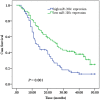Serum miR-200c and clinical outcome of patients with advanced esophageal squamous cancer receiving platinum-based chemotherapy
- PMID: 24349623
- PMCID: PMC3853426
Serum miR-200c and clinical outcome of patients with advanced esophageal squamous cancer receiving platinum-based chemotherapy
Abstract
MicroRNA-200c (miR-200c) influences sensitivity to chemotherapy and radiotherapy in vitro. This study was designed to investigate the prognostic potential of serum miR-200c in patients with advanced esophageal squamous cancer (ESCC). The serum levels of miR-200c was assayed by quantitative RT-PCR in 157 healthy subjects and 157 patients with advanced ESCC who were treated with platinum-based chemotherapy. The serum levels of miR-200c in advanced ESCC patients was significantly increased compared with those in controls (P < 0.001). Serum miR-200c expression was significantly associated with TNM stage (P = 0.037) and treatment response (P = 0.021). Patients with high expression of serum miR-200c had a higher risk for death than those with low expression of serum miR-200c (adjusted hazard ratios = 1.665, 95% confidence intervals: 1.135-2.443, P = 0.009). In conclusion, serum miR-200c may serve as predictor of survival for advanced ESCC and provide information for personalized therapy in advanced ESCC.
Keywords: Esophageal squamous cancer; chemotherapy; miR-200c; microRNA; platinum.
Figures


Similar articles
-
Prognostic Value and Clinicopathology Significance of MicroRNA-200c Expression in Cancer: A Meta-Analysis.PLoS One. 2015 Jun 2;10(6):e0128642. doi: 10.1371/journal.pone.0128642. eCollection 2015. PLoS One. 2015. PMID: 26035744 Free PMC article.
-
MicroRNA-200c as a prognostic and sensitivity marker for platinum chemotherapy in advanced gastric cancer.Oncotarget. 2017 Apr 13;8(31):51190-51199. doi: 10.18632/oncotarget.17087. eCollection 2017 Aug 1. Oncotarget. 2017. PMID: 28881640 Free PMC article.
-
Circulating miR-200c levels significantly predict response to chemotherapy and prognosis of patients undergoing neoadjuvant chemotherapy for esophageal cancer.Ann Surg Oncol. 2013 Dec;20 Suppl 3:S607-15. doi: 10.1245/s10434-013-3093-4. Epub 2013 Jul 10. Ann Surg Oncol. 2013. PMID: 23838916
-
Correlation of plasma miR-21 and miR-93 with radiotherapy and chemotherapy efficacy and prognosis in patients with esophageal squamous cell carcinoma.World J Gastroenterol. 2019 Oct 7;25(37):5604-5618. doi: 10.3748/wjg.v25.i37.5604. World J Gastroenterol. 2019. PMID: 31602161 Free PMC article.
-
Serum miR-200c expression level as a prognostic biomarker for gastric cancer.Genet Mol Res. 2015 Dec 7;14(4):15913-20. doi: 10.4238/2015.December.7.2. Genet Mol Res. 2015. PMID: 26662382
Cited by
-
Prognostic significance of microRNA-200c in various types of cancer: An updated meta-analysis of 34 studies.Mol Clin Oncol. 2016 Jun;4(6):933-941. doi: 10.3892/mco.2016.842. Epub 2016 Mar 30. Mol Clin Oncol. 2016. PMID: 27284426 Free PMC article.
-
Prognostic value of miR-221-3p, miR-342-3p and miR-491-5p expression in colon cancer.Am J Transl Res. 2014 Jul 18;6(4):391-401. eCollection 2014. Am J Transl Res. 2014. PMID: 25075256 Free PMC article.
-
Plasma microRNA-9 as a diagnostic and prognostic biomarker in patients with esophageal squamous cell carcinoma.J Int Med Res. 2017 Aug;45(4):1310-1317. doi: 10.1177/0300060517709370. Epub 2017 Jun 6. J Int Med Res. 2017. PMID: 28587538 Free PMC article.
-
The role of miR-200 family in the regulation of hallmarks of cancer.Front Oncol. 2022 Sep 8;12:965231. doi: 10.3389/fonc.2022.965231. eCollection 2022. Front Oncol. 2022. PMID: 36158660 Free PMC article. Review.
-
Prognostic Value and Clinicopathology Significance of MicroRNA-200c Expression in Cancer: A Meta-Analysis.PLoS One. 2015 Jun 2;10(6):e0128642. doi: 10.1371/journal.pone.0128642. eCollection 2015. PLoS One. 2015. PMID: 26035744 Free PMC article.
References
-
- Enzinger PC, Mayer RJ. Medical progress - Esophageal cancer. N Engl J Med. 2003;349:2241–2252. - PubMed
-
- Zhang T, Wang Q, Zhao D, Cui Y, Cao B, Guo L, Lu SH. The oncogenetic role of microRNA-31 as a potential biomarker in oesophageal squamous cell carcinoma. Clin Sci (Lond) 2011;121:437–447. - PubMed
-
- Hiyama T, Yoshihara M, Tanaka S, Chayama K. Genetic polymorphisms and esophageal cancer risk. Int J Cancer. 2007;121:1643–1658. - PubMed
-
- Barber TW, Duong CP, Leong T, Bressel M, Drummond EG, Hicks RJ. 18F-FDG PET/CT has a high impact on patient management and provides powerful prognostic stratification in the primary staging of esophageal cancer: a prospective study with mature survival data. J Nucl Med. 2012;53:864–871. - PubMed
-
- Tachimori Y, Kanamori N, Uemura N, Hokamura N, Igaki H, Kato H. Salvage esophagectomy after high-dose chemoradiotherapy for esophageal squamous cell carcinoma. J Thorac Cardiovasc Surg. 2009;137:49–54. - PubMed
LinkOut - more resources
Full Text Sources
